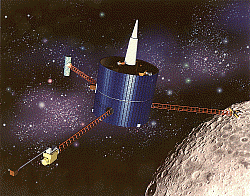Lunar Prospector

Lunar Prospector was the third mission in NASA's Discovery Program and the first to be competitively selected. Lunar Prospector was launched on 6 January 1998, and, five days later, entered a polar orbit around the Moon, 101 kilometers (63 miles) high, at the start of its year-long primary mission.
The 1.4-meter by 1.2-meter drum-shaped spacecraft is equipped with 5 instruments mounted on three 2.5-meter long booms. One of the instruments is a neutron spectrometer (the first device of this type to be carried aboard an interplanetary probe) designed to verify the existence of water ice at the lunar poles as first suggested by measurements made by Clementine in 1994. The neutron spectrometer detects water indirectly. When cosmic rays strike atoms in the lunar crust, they throw out neutrons and other particles at high energies. Such neutrons are said to be 'hot' or 'fast'. Some of them escape directly into space, while others bounce around among atoms in the crust. If they collide with heavy atoms, they lose little energy and escape still 'hot'. However, if a dislodged neutron bumps into a hydrogen atom in the surface rocks it loses much of its energy and then escapes into space as a "cool" or epithermal neutron. The neutron spectrometer aboard Lunar Prospector looks for these epithermal neutrons as a signature for hydrogen on the surface. Traces of hydrogen could be implanted in the Moon's rocks by the solar wind, but significant amounts of hydrogen could only reasonably be accounted for by the presence of water ice. On 5 March 1998, came the announcement that Lunar Prospector had confirmed Clementine's earlier discovery; however, the existence of lunar ice has since been called into question.


